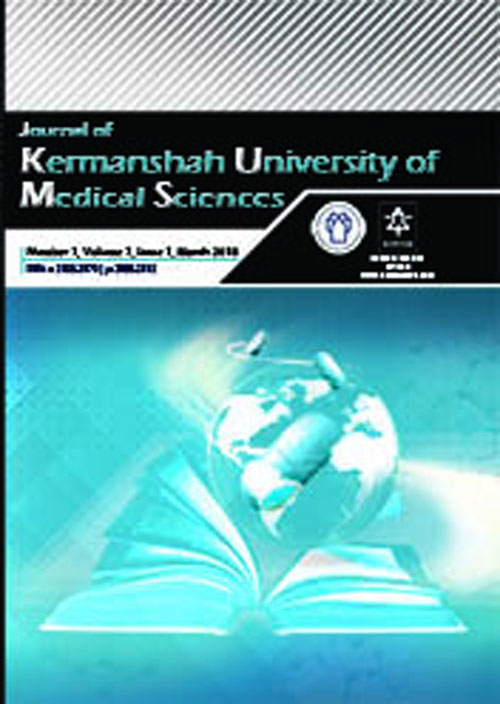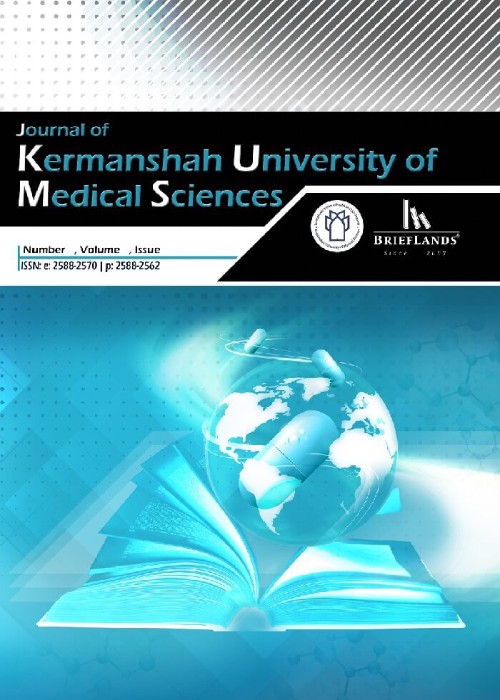فهرست مطالب

Journal of Kermanshah University of Medical Sciences
Volume:25 Issue: 4, Dec 2021
- تاریخ انتشار: 1400/11/18
- تعداد عناوین: 8
-
-
Page 1
Context:
Infections are a major cause of disease and mortality in transplant recipients. Despite the studies conducted in Iran, no comprehensive and general research is available in this area. The present study aimed to determine the frequency of infectious agents in patients after bone marrow transplantation in Iran.
MethodIn this systematic review, relevant studies were selected based on type and objective, and data were collected from the articles published in Iran regarding the frequency of infectious agents after bone marrow transplantation in different regions of Iran. The studies were collected using systematic search methods.
ResultsIn total, 11 studies were identified regarding infectious agents after bone marrow transplantation. Six studies were conducted in Tehran, three studies were performed in Shiraz, and Mashhad and Semnan provinces were the locations of two separate studies. Most of the case studies identified viral agents (54.5%; n = 6), followed by fungal infectious agents (27.3%; n = 3) and bacterial agents (18.2%; n = 2). Gram-positive bacteria (bacterial agents), cytomegalovirus (viral agents), and Candida and Aspergillus (fungi) had the highest frequency after bone marrow transplantation.
ConclusionsAccording to the results, viral, fungal, and bacterial infectious agents were respectively most frequent in patients receiving bone marrow transplants. Gram-positive bacteria (bacterial agents), cytomegalovirus (viral agents), and Candida and Aspergillus (fungi) had the highest frequency after bone marrow transplantation.
Keywords: Regions of Iran, Systematic Review, Infections, Bone Marrow Transplantation -
Page 2Background
Although coronavirus disease 2019 (COVID-19) is a respiratory disease, it seems that liver abnormalities are also prevalent in the patients.
ObjectivesThe present study aimed to evaluate liver enzymes in COVID-19 patients.
MethodsThis descriptive, cross-sectional study was conducted on 111 COVID-19 patients admitted to Imam Reza Hospital in Kermanshah during September-November 2020. The required data were extracted from the hospital files, and data analysis was performed in the Excel software and SPSS version 21.
ResultsThe mean age of the patients was 60.87 ± 15.85 years. 50.5% of patients were female. Among the patients, 38.7% had hypertension, 19.8% had diabetes, and 7.2% had cardiovascular diseases. Moreover, 34.2% of the patients had abnormal aspartate aminotransferase (AST), 17.1% had abnormal alanine aminotransferase (ALT), and 100% had abnormal lactate dehydrogenase (LDH).
ConclusionsAccording to the results, hypertension, diabetes, and cardiovascular diseases were the most common comorbidities among the COVID-19 patients. AST, ALT, and LDH are important indicators of hepatic disorders, which were abnormal in these patients as well. Moreover, the patients aged less than 60 years, male patients, and those with renal disorders had a higher mean ALT.
Keywords: LDH, ALT, AST, Liver Enzymes, Coronavirus, COVID-19 -
Page 3Background
Complications of multiple sclerosis (MS) severely impact self-image and have debilitative effects on the adversity quotient.
ObjectivesThe present study aimed to investigate the effects of the choice theory and behavioral activation therapies with and without guided imagery rescripting on the adversity quotient and cognitive emotion regulation of MS patients in Ahvaz, Iran.
MethodsThis quasi-experimental study was conducted with a pretest-posttest design and a control group. The sample population included the male and female MS patients visiting the Caspian Physiotherapy Center of Ahvaz, Iran in 2019. In total, 60 MS patients were selected via convenience sampling and randomly divided into three experimental groups and one control group (15 per each). Data were collected using the Adversity Response Profile Questionnaire (ARPQ) and the Cognitive Emotion Regulation Questionnaire (CERQ). Data analysis was performed using the multivariate analysis of covariance.
ResultsA significant difference was observed between the effects of the choice theory (CT) and behavioral activation (BA) therapies with and without guided imagery rescripting (ImRs) on the improvement of the adversity quotient (AQ) and positive cognitive emotion regulation (CER) of the MS patients, as well as the reduction of negative CER (P < 0.001). Compared to the CT and BA therapies without guided ImRs, the BA therapy with guided ImRs more effectively enhanced the AQ and positive CER of the MS patients and decreased their negative CER (P < 0.001).
ConclusionsAccording to the results, BA with ImRs is a more effective method for enhancing the AQ and positive CER of MS patients and mitigating their negative CER compared to other approaches.
Keywords: Multiple Sclerosis (MS), Emotions, Cognitive, Adversity, Imagery Behavior -
Page 4Background
Excessive use of antibiotics has led to drug resistance. As such, stewardship programs are implemented to control antibiotic use in hospitalized patients.
ObjectivesThe present study aimed to evaluate the frequency of antibiotic use after the implementation of the stewardship program.
MethodsThis retrospective study was conducted on the patients admitted to Imam Reza Hospital in Kermanshah, Iran during 2017 - 2018. The required data were extracted from the pharmaceutical ward of the hospital. Data analysis was performed in SPSS version 24.
ResultsThe median per capita numerical and Rial consumption of caspofungin and linezolid antibiotics increased after the implementation of the stewardship plan, while the consumption of imipenem, amphotericin, teicoplanin, colistin, meropenem, voriconazole, and vancomycin was observed to decrease. In addition, the median per capita of the numerical use of caspofungin and linezolid increased in the surgery ward, intensive care unit (ICU), and internal medicine ward after the implementation of the stewardship plan. On the other hand, a reduction was observed in the use of amphotericin, colistin, voriconazole, and vancomycin in only one ward. The use of meropenem and teicoplanin also increased in the surgery ward and decreased in the other wards, while the use of imipenem increased in the ICU after implementing the plan and decreased in the other wards. The median use of antibiotics was not considered significant in the internal medicine ward, surgery ward, and ICU before and after implementing the stewardship program (P > 0.05).
ConclusionsAccording to the results, antibiotic use slightly decreased after the implementation of the stewardship program. However, an increase was also observed in antibiotic prescription in some cases, which indicated that the stewardship program was not implemented properly, and no changes occurred in antibiotics prescription.
Keywords: Parenteral, Cost, Stewardship, Antibiotics -
Page 5Background
Staphylococcus aureus is an opportunistic pathogen, which often causes asymptomatic diseases. This bacterium could cause several disorders, ranging from skin infections to life-threatening diseases. S. aureus could also develop resistance to a wide range of antibiotics.
ObjectivesThe present study aimed to investigate the prevalence and pattern of antibiotic resistance in isolated S. aureus in Imam Reza Hospital of Kermanshah, Iran.
MethodsThis descriptive cross-sectional study was conducted on 2,228 patients with a positive S. aureus culture who were admitted to Imam Reza Hospital during 2016 - 2018. In accordance with the CLSI protocol, bacterial isolates were separated using laboratory tests, and antibiotic susceptibility was assessed using the standard disk-diffusion method. Data analysis was performed in SPSS version 24.
ResultsMost of the S. aureus-positive cases were isolated from the emergency ward (43.7%), blood samples (40.1%), and urine samples (23.9%). The highest antibiotic resistance was observed against erythromycin, penicillin G, ofloxacin, cefoxitin, clindamycin, and piperacillin. With 93.3% and 81.8% sensitivity, vancomycin and teicoplanin were respectively the most effective antibiotics against S. aureus.
ConclusionsAccording to the results, the prevalence of resistant S. aureus strains could be due to the long-term hospitalization of patients and the overuse of antibiotics in infection treatment. Therefore, proper monitoring and development of effective infection control methods are essential in these healthcare settings.
Keywords: Antibiotic Resistance, Staphylococcus aureus, Nosocomial Infection -
Page 6Background
Due to the changing nature of the spread of emerging infectious diseases, such crises could cause significant fear, especially when the disease is associated with high mortality. Fear and anxiety adversely affect health.
ObjectivesThe present study aimed to investigate the fear and anxiety caused by COVID-19 in the Iranian society and the influential factors in this regard.
MethodsThis correlational study was conducted on 458 participants who were recruited for an online survey. Data were collected using a researcher-made questionnaire of COVID-19 fear and Beck's anxiety inventory. Data analysis was performed in SPSS version 23 using descriptive statistics (frequency, percentage, mean, and standard deviation) and inferential statistics, including t-test and multiple comparisons.
ResultsThe prevalence of fear and anxiety was less than 20%. The correlations between the anxiety scores and fear of COVID-19 with demographic variables indicated that the COVID-19 fear scores had a weak correlation with an appeal to religion and efforts to prevent COVID-19 (P ≤ 0.05), while no correlation was observed with the other variables. In addition, the anxiety scores had weak, inverse correlations with the effort to prevent COVID-19 and satisfaction with the government’s effort (P ≤ 0.05).
ConclusionsAccording to the results, the fear of COVID-19 and the subsequent anxiety is mild in the Iranian society. Low anxiety and fear caused by the disease could lead to negligence and disregarding health standards, which will increase the number of these patients in the community.
Keywords: Iran, COVID-19, Fear, Anxiety -
Page 7Background
Persuasion is a method used to correct and modify the attitude and behaviors of community members to protect collective benefits, especially during crises.
ObjectivesThe present study aimed to predict COVID-19 preventive behaviors based on persuasion techniques in five countries.
MethodsThis descriptive, correlational study was conducted on the population aged more than 18 years in Iran, Australia, the United Kingdom, Sweden, and Canada. The sample size determined by Morgan’s table was 498 individuals who were selected via convenience sampling in the spring of 2020. Data were collected online using a Demographic Questionnaire, a Persuasion Scale (2020), and the Questionnaire of Healthy Preventive Behaviors for COVID-19 (2020). The inclusion criteria were the age of more than 18 years and basic literacy, and the exclusion criterion was incomplete questionnaires. Data analysis was performed in SPSS version 21 using Pearson’s correlation-coefficient and multiple regression analysis.
ResultsA positive significant correlation was observed between persuasion techniques and healthy preventive behaviors for COVID-19 (P < 0.001). Among the components of persuasion, fear, interest in the messenger, frequency of the message, and reliability of the messenger could most significantly predict healthy behaviors (P < 0.001).
ConclusionsAccording to the results, the mass media and authorities could enhance the effectiveness of their agenda by identifying the influential factors in the success of persuasion techniques. These findings could be beneficial to social psychiatrists, authorities, and the mass media.
Keywords: Self-care Behaviors, COVID-19, Persuasion -
Page 8Background
Self-harming behaviors are significantly associated with difficulty in emotion regulation. Attachment styles and childhood trauma increase the frequency and intensity of self-harming behaviors through disrupting emotion regulation.
ObjectivesThe present study aimed to evaluate the mediating role of difficulties in emotion regulation in the correlation between attachment styles and childhood trauma with self-harming behaviors in adolescents.
MethodsThe sample population included adolescents aged 15-18 years in Kermanshah, Iran in 2019. In total, 400 participants were selected via random sampling. Data were collected using instruments of difficulties in emotion regulation scale (DERS), adult attachment questionnaire (AAQ), and childhood trauma questionnaire (CTQ). In addition, structural equation modeling (SEM) was used to evaluate the proposed model. Data analysis was performed in SPSS version 24 and AMOS version 23.
ResultsThe proposed model had a good fit. Attachment styles with the mediation of difficulties in emotion regulation (β = 0.174) and childhood trauma with the mediation of difficulties in emotion regulation (β = 0.111) had an indirect, significant correlation with self-harming behaviors (P < 0.05).
ConclusionsAccording to the results, attachment styles and childhood trauma affected self-harming behaviors through difficulties in emotion regulation. Therefore, their impact on self-harming behaviors could be reduced by improving emotion regulation in adolescents.
Keywords: Adolescents, Self-harming Behaviors, Childhood Trauma, Attachment Styles, Difficulties in Emotion Regulation


